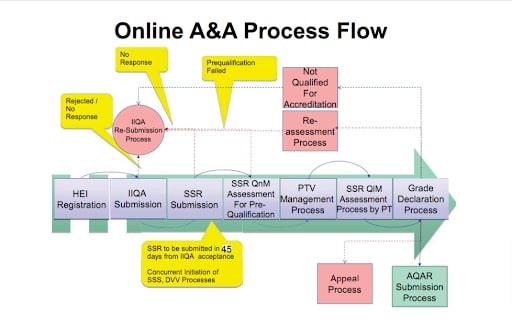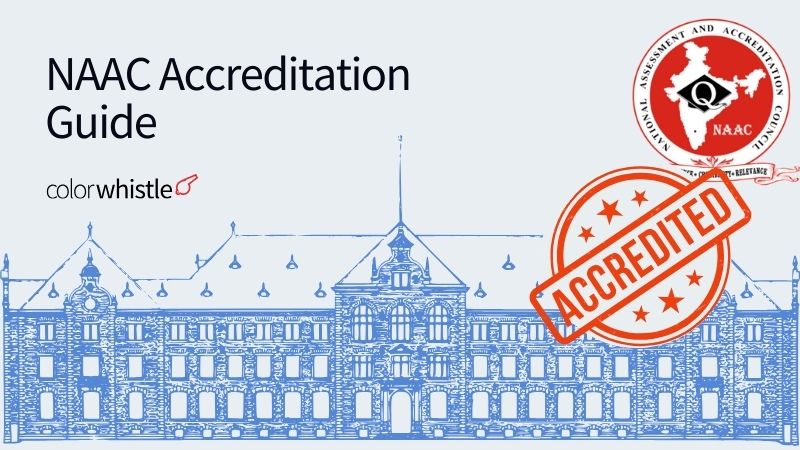So, you were searching for ‘NAAC Accreditation’ and somehow ended up on this blog. Then you look at the site name and, wait a minute….. it says ‘website development company.’ You’re probably thinking, ‘How did these guys end up writing articles about NAAC?’
Well, We worked with a well-known engineering college in Coimbatore, India to revamp their website, and during that process, we got a front-row seat to their NAAC accreditation struggles. That got us thinking, why not help out other colleges in India facing the same challenges? So here we are, helping you better prepare for your own NAAC accreditation journey. We’ve started with an outline, so stay tuned for more in-depth content on NAAC.
What is NAAC?
The National Assessment and Accreditation Council (NAAC) is an autonomous body established by the University Grants Commission (UGC) in 1994. It assesses and accredits higher education institutions in India. NAAC’s mission is to promote and support quality assurance in higher education and to encourage institutions to enhance their academic and administrative standards.
NAAC evaluates institutions based on several parameters, such as teaching-learning processes, research, infrastructure, and governance. Institutions receive a grade that reflects their overall performance, with A++ being the highest.
Benefits of NAAC Accreditation
NAAC accreditation is vital for educational institutions in India for multiple reasons:
- Enables the institution to assess its strengths, weaknesses, and opportunities through a comprehensive review process
- Facilitates the identification of internal areas for strategic planning and resource distribution
- Promotes a spirit of collegiality across the campus
- Provides objective performance data that funding agencies consider for financial support
- Encourages institutions to adopt innovative and modern teaching methods
- Helps institutions develop a new sense of direction and identity
- Offers society reliable information about the quality of education provided
- Provides employers with trustworthy data on the educational qualifications of potential recruits
- Enhances both internal and external institutional collaborations
Key Criteria for NAAC Assessment
- Curricular Aspects: Institutions are evaluated on how well they design and implement their curriculum, keeping it updated and relevant to industry needs
- Teaching-Learning and Evaluation: This involves the methods used for teaching and the fairness and transparency of the evaluation process
- Research, Innovations, and Extensions: Research activities, innovations, and the institution’s outreach to the community play a crucial role in assessment
- Infrastructure and Learning Resources: Institutions are rated on the quality and availability of infrastructure such as labs, libraries, and online resources
- Student Support and Progression: NAAC evaluates the support services provided to students, including scholarships, career counseling, and overall student well-being
- Governance, Leadership, and Management: Effective leadership, transparency in administration, and well-defined governance are essential for a high NAAC score
- Institutional Values and Best Practices: How the institution upholds its core values and implements innovative practices is also considered
Eligibility Criteria for NAAC Accreditation for Educational Institutions in India
The eligibility criteria for NAAC accreditation vary depending on the type of institution applying. Below are the specific eligibility requirements for Universities, Affiliated/Constituent Colleges, and Autonomous Colleges.
Also Read
Universities (Central / State / Private / Deemed-to-be) and Institutions of National Importance
- MHRD/UGC Approval: The institution or its off-campuses must be approved by the Ministry of Human Resource Development (MHRD) or the University Grants Commission (UGC). NAAC will not accredit unapproved off-campuses
- Regular Student Enrollment: Institutions must have full-time students enrolled in on-campus teaching and research programs
- Onshore Campuses: Only duly established campuses within India are eligible for accreditation. NAAC does not accredit offshore campuses
- Special Provision: Any other Higher Education Institutions (HEIs) may be considered at the discretion of NAAC
Autonomous / Constituent / Affiliated Colleges
- Affiliation Requirement: Colleges must be affiliated with a UGC-recognized university. Constituent colleges of Private and Deemed-to-be Universities are treated as units of the university and will not be accredited independently
- Professional Programs: Colleges not affiliated with a university but offering programs recognized by statutory bodies and deemed equivalent to university degrees by agencies like the Association of Indian Universities (AIU) are also eligible
Accredited Institutions Seeking Reassessment or Subsequent Cycles
- Reassessment: Institutions wanting to improve their accreditation status can apply for reassessment after at least one year but before three years of their current accreditation
- Subsequent Cycles: Institutions applying for Cycle 2, Cycle 3, or Cycle 4 accreditation must submit their Institutional Information for Quality Assessment (IIQA) within the last six months of their accreditation validity period
Additional Notes
- Distance Education and Offshore Campuses: NAAC does not cover distance education units or offshore campuses of HEIs
- AISHE Portal Registration: All institutions must upload their information on the All India Survey on Higher Education (AISHE) portal and obtain an AISHE reference code, which is a requirement for NAAC registration
Step-by-Step Guide for the NAAC Accreditation Process

Getting the NAAC accreditation process can seem daunting, but breaking it down into steps makes it manageable
When an institution undergoes the accreditation process for the first time, it is called Cycle 1, with subsequent five-year intervals designated as Cycles 2, 3, and so on.
For Cycle 1 (First-Time Accreditation)
1. HEI Registration
The Higher Education Institution (HEI) initiates the accreditation process by registering on the NAAC portal.
2. IIQA Submission (Institutional Information for Quality Assessment)
After registration, the institution submits the IIQA for the NAAC to assess eligibility for the accreditation process.
Outcomes
- If Rejected or No Response, the institution undergoes the IIQA Re-Submission Process
- If the institution fails Prequalification, they must go through the Re-assessment Process
3. SSR Submission (Self Study Report)
After acceptance of the IIQA, the institution submits the SSR within 45 days. Concurrently, the processes for the Student Satisfaction Survey (SSS) and Data Validation & Verification (DVV) begin.
4. SSR QnM Assessment for Pre-Qualification
Quantitative metrics (QnM) in the SSR are assessed to prequalify the institution.
Outcomes
- If the institution is Not Qualified for Accreditation, they must proceed to the Re-assessment Process.
5. PTV Management Process (Peer Team Visit)
The institution undergoes the PTV process where a peer team visits to validate the SSR findings.
6. SSR QIM Assessment Process by PT
The qualitative metrics (QIM) of the SSR are assessed by the Peer Team (PT).
7. Grade Declaration Process
- After the evaluation, the grades are declared for the institution
- Appeal Process: If the institution is unsatisfied with the declared grade, they may initiate the Appeal Process
8. AQAR Submission Process (Annual Quality Assurance Report)
Post-accreditation, the institution must submit the AQAR annually to maintain its accreditation status.
For Cycles 2, 3, and Beyond (Re-Accreditation)
- Internal Quality Assurance Cell (IQAC): The IQAC must be active and functioning within the institution
- Annual Quality Assurance Reports (AQARs): Institutions must submit AQARs annually to maintain the quality standards
- IIQA Submission: Institutions must submit the IIQA six months before their current accreditation expires
- Other Steps: The process remains the same as Cycle 1, including submitting the SSR, a peer team visit, and final grading
Variations for Different Institutions
- Universities focus on continuous improvements and must meet UGC/MHRD approval standards
- Autonomous Colleges need to demonstrate curriculum updates and active quality assurance efforts
- Affiliated Colleges must maintain affiliation with a UGC-recognized university and ensure program recognition by relevant statutory bodies
This ensures that all institution types follow a similar core process but address their unique needs in subsequent cycles.
Grading System in NAAC Accreditation
NAAC follows a grading system based on a cumulative grade point average (CGPA) that ranges from 1.51 to 4.00. The grades are:
- A++: Institutions with CGPA between 3.51 and 4.00
- A+: CGPA between 3.26 – 3.50
- A: CGPA between 3.01 – 3.25
- B++: CGPA between 2.76 – 3.00
- B+: CGPA between 2.51-2.75
- B: CGPA between 2.01 – 2.50
- C: CGPA between 1.51 and 2.00
- D: Institutions scoring below 1.50 are not accredited
What is IQAC in NAAC Accreditation for Educational Institutions in India?
The Internal Quality Assurance Cell (IQAC) is an essential body within institutions aiming for NAAC accreditation. It is responsible for planning and implementing quality initiatives. The IQAC ensures continuous improvement in all academic and administrative processes and is key in preparing for NAAC assessments.
Documents to be Submitted with IIQA (Institutional Information for Quality Assessment)
During the online submission of the IIQA, the following documents (where applicable) must be uploaded in PDF format.
(Note: The file size should not exceed 1MB)
- The most recent affiliation letter from the affiliating university
- Latest recognition/approval letter from statutory regulatory authorities (SRA) such as AICTE, MCI, etc
- UGC 2f and 12(B) recognition certificate along with the latest General Development Grant release letter from UGC
- UGC letter regarding the award of CPE/UPE status
- For autonomous colleges, the UGC letter confers autonomous status
- Proof of uploading the All India Survey on Higher Education (AISHE) certificate
- If there is a change in the institution’s name, submit approvals from the relevant authorities/University/MHRD/UGC
- Approval from UGC/MHRD/State Government for the establishment of the university
- AIU or other governmental agency approval for standalone institutes
- Upload AQARs on the website and provide the relevant URL details
- A self-declaration by the Higher Education Institution (HEI) confirming compliance with the rules and regulations of the Central Government, State Government, UGC, affiliating university, and other applicable SRAs, in the format provided by NAAC
- A self-declaration regarding affiliation status, in the format provided by NAAC
The philosophy of NAAC is focused on improvement and empowerment rather than being punitive or judgmental, aiming to help all stakeholders in higher education institutions enhance their resources, opportunities, and capabilities to the fullest.
Also Read
Why is a Website Essential for Higher Education Institutions and Crucial for NAAC Accreditation?
A website is essential for higher education institutions because it serves as a central hub for information, making it easy for students, parents, and faculty to access important details like admissions, courses, and events. It also boosts the institution’s visibility, helping attract prospective students, showcase academic programs, and strengthen the institution’s reputation.
Also, the college website plays a crucial role in the NAAC accreditation process for several reasons:
Transparency and Public Information
- Mission and Vision: The website should clearly present the institution’s mission, vision, objectives, and goals, which are critical for NAAC’s assessment of institutional clarity and focus
- Academic Programs and Policies: It provides detailed information about courses, faculty, admission processes, fee structures, and institutional policies, ensuring transparency for students, parents, and other stakeholders
Compliance with NAAC Requirements
- Institutions are required to upload their Self-Study Report (SSR) and other documents like Annual Quality Assurance Reports (AQARs) and Institutional Information for Quality Assessment (IIQA) on their website for public access
- This allows NAAC assessors to review these documents during the accreditation process
Demonstrating Technological Integration
A well-maintained website demonstrates the institution’s use of technology in its operations and services, which is a key factor in NAAC’s evaluation of institutional management and technological integration.
Ease of Access for NAAC Peer Team
- NAAC-appointed peer teams use the website to verify claims made in the SSR, check for compliance with statutory bodies, and review the institution’s functioning
- A comprehensive website simplifies the peer team’s verification process
Showcasing Quality and Best Practices
A website allows institutions to highlight their best practices, research achievements, faculty qualifications, student support services, and other quality initiatives, all of which contribute to a positive NAAC evaluation.
Promotes Continuous Improvement
Regularly updating the website with academic progress, events, publications, and feedback systems shows an institution’s commitment to continuous quality improvement, a key aspect of NAAC accreditation.
Stakeholder Engagement
The website is a platform for engaging with students, faculty, alumni, and the community. NAAC values how institutions interact with their stakeholders, and a dynamic, user-friendly website facilitates this
Effective use of ICT in higher education institutions (HEIs) can enhance ICT literacy, facilitate resource sharing, and improve administrative processes. Consequently, NAAC accreditation evaluates how well HEIs implement electronic data management systems and provide access to electronic resources for internal and external stakeholders, especially students.
The website is not just a communication tool but an essential digital asset that reflects the institution’s transparency, technological capabilities, and overall quality, all of which are critical for NAAC accreditation.
Remain alert for the best practices colleges should follow when developing a website.
Top 5 A++ NAAC Accredited Universities in Tamil Nadu
| University Names | Address | CGPA | Grade | Declaration Date |
|---|---|---|---|---|
| Shanmuga Arts, Science, Technology and Research Academy | SASTRA Deemed University Tirumalaisamudram, Thanjavur,Tamil Nadu, 613401 | 3.76 | A++ | 08-03-2022 |
| Sathyabama Insitute of Science and Technology | Jeppiaar Nagar, Rahiv Gandhi Salai, Chennai, Tamil Nadu, 600119 | 3.73 | A++ | 19-05-2023 |
| Chettinad Academy of Research and Education | Rajiv Gandhi Salai, Kelambakkam, Chengalpattu District, Kanchipuram, Tamil Nadu, 603103 | 3.71 | A++ | 14-06-2022 |
| Amrita Vishwa Vidyapeetham | Ettimadai PO Coimbatore, Tamil Nadu, 641112 | 3.7 | A++ | 17-08-2021 |
| Vellore Institute of Technology | Katpadi - Thiruvalam Road, Vellore, Tamil Nadu, 632014 | 3.66 | A++ | 31-08-2021 |
Click to View More (Source naac.gov.in)
Top 5 A+ NAAC Accredited Universities in Tamil Nadu
| University Names | Address | CGPA | Grade | Declaration Date |
|---|---|---|---|---|
| Meenakshi Academy of Higher Education and Research | No. 12, Vembuliamman Koil Street, West K.K Nagar, Chennai - 600078, Tamil Nadu | 3.5 | A+ | 23-11-2023 |
| Dr. M.G.R Educational And Research Institute | E.V.R Periyar Salai, Maduravoyal, Chennai, Tamil Nadu, 600095 | 3.48 | A+ | 02-08-2022 |
| Hindustan Institute of Technology and Science | No 1, Rajiv Gandhi Salai, OMR, Padur, Kelambakkam, Chennai,Kanchipuram, Tamil Nadu, 603103 | 3.48 | A+ | 06-10-2023 |
| Central University of Tamil Nadu | Neelakudi, Tiruvarur, Tamil Nadu, 610005 | 3.44 | A+ | 23-05-2024 |
| Annamalai University | Annamalainagar, Cuddalore, Tamil Nadu, 608002 | 3.38 | A+ | 21-06-2022 |
Click to View More (Source naac.gov.in)
Top 10 A++ NAAC Accredited Colleges in Tamil Nadu
| College Names | Address | CGPA | Grade | Declaration Date |
|---|---|---|---|---|
| Nirmala College for Women | Red fields, Coimbatore, Tamil Nadu, 641018 | 3.78 | A++ | 01-05-2023 |
| Holy Cross College (Autonomous) | Teppakulam Post, Tiruchirappalli, Tamil Nadu,620002 | 3.75 | A++ | 14-02-2020 |
| Sri S.Ramasamy Naidu Memorial College | Sadayampatti, Sattur, Virudhunagar District, Tamil Nadu, 626203 | 3.74 | A++ | 10-01-2023 |
| PSGR Krishnammal College for Women (Autonomous) | Avinashi Road, Peelamedu, Coimbatore,Tamil Nadu,641004 | 3.71 | A++ | 17-08-2021 |
| Sri Krishna College of Engineering and Technology | Sugunapura,, Kuniamuthur, Coimbatore, Tamil Nadu, 641008 | 3.71 | A++ | 09-08-2024 |
| Bon Secours College for Women | Vilar Bypass, Thanjavur, Tamil Nadu, 613006 | 3.71 | A++ | 14-12-2021 |
| Bishop Heber College (Autonomous) | Allithurai Road, Puthur, Tiruchirappalli, Tamil Nadu,620017 | 3.69 | A++ | 14-09-2023 |
| Jamal Mohamed College | No 7, Race Course Road, Khaja Nagar, Tiruchirappalli, Tamil Nadu, 620020 | 3.69 | A++ | 27-09-2023 |
| Hindusthan College of Engineering and Technology | Valley Campus, Pollachi Highway, Coimbatore, Tamil Nadu, 641032 | 3.69 | A++ | 06-10-2023 |
| K.S.R College of Engineering | K.S.R. Kalvi Nagar, Thokkavadi (PO) ,Tiruchengode, Namakkal, Tamil Nadu, 637215 | 3.69 | A++ | 17-01-2023 |
Click to View More (Source naac.gov.in)
Top 10 A+ NAAC Accredited Colleges in Tamil Nadu
| College Names | Address | CGPA | Grade | Declaration Date |
|---|---|---|---|---|
| C. Abdul Hakeem College | Hakeem Nagar, Melvisharam, Ranipet District. Vellore, Tamil Nadu, 632509 | 3.5 | A+ | 21-09-2022 |
| Nehru Arts and Science College | Nehru Gardens, Thirumalayampalayam, Coimbatore, Tamil Nadu, 641105 | 3.5 | A+ | 02-06-2023 |
| Mohamed Sathak Engineering College | East Coast Road, Mayakulam Panchayat, Kilakarai., Ramanathapuram, Tamil Nadu, 623806 | 3.49 | A+ | 21-04-2023 |
| Kongu Arts and Science College | Kathirampatti(post), Nanjanapuram, Erode, Tamil Nadu, 638107 | 3.49 | A+ | 30-11-2023 |
| Kathir College of Engineering | Wisdom Tree, Avinashi Road, Near Bye Pass, Neelambur, Coimbatore, Tamil Nadu, 641062 | 3.49 | A+ | 28-02-2023 |
| Ayya Nadar Janaki Ammal College (Autonomous) | Srivilliputhur Road, Sivakasi, Tamil Nadu, 626124 | 3.48 | A+ | 14-02-2020 |
| Subbalakshmi Lakshmipathy College of Science | TVR Nagar, Aruppukottai Road, Madurai, Tamil Nadu, 625022 | 3.48 | A+ | 23-08-2024 |
| Erode Arts and Science College | 205, Chennimalai Road, Rangampalayam, Erode, Tamil Nadu, 638009 | 3.48 | A+ | 02-05-2024 |
| The American College (Autonomous) | ALAGAR KOIL ROAD, TALLAKULAM, Madurai, Tamil Nadu, 625002 | 3.47 | A+ | 12-04-2022 |
| Chennai Institute of Technology | Sarathy Nagar, Puduper, Nandhambakkam Post, Kundrathur, Chennai, Tamil Nadu,600069 | 3.47 | A+ | 14-06-2022 |
Click to View More (Source naac.gov.in)
Wrap Up
NAAC accreditation plays a critical role in shaping the quality of higher education in India. It not only acts as a quality benchmark but also drives continuous improvement in academic institutions. For students, faculty, and administrators alike, NAAC accreditation signifies a commitment to excellence. Institutions that are proactive in improving their educational standards through the NAAC accreditation process set themselves apart as leaders in higher education.
Browse our ColorWhistle page for more related content and learn about our services. To contact us and learn more about our services, please visit our Contact Us page.
What’s Next?
Now that you’ve had the chance to explore our blog, it’s time to take the next step and see what opportunities await!







This was a great breakdown of NAAC accreditation. It’s amazing how standards for higher education can be so similar to the best practices in other sectors. For instance, in fashion retail, ghost mannequin photography helps maintain quality and consistency across products, much like accreditation ensures consistency in education.